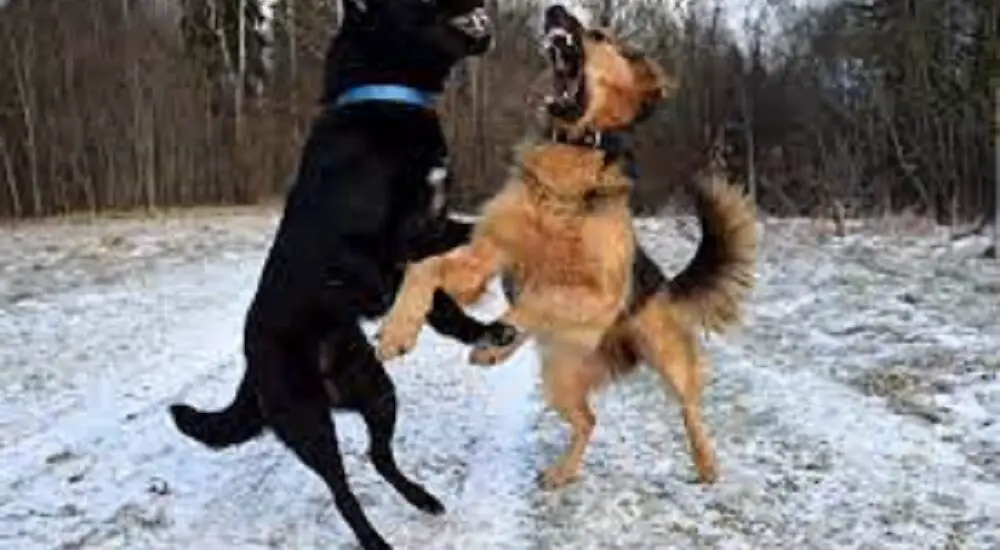If you find yourself in the stressful and alarming situation where you need to know how to get dog off another dog, rest assured, help is available. This guide will provide you with all the essential steps required to handle the issue safely and effectively.

Photo from Pxhere
Table of Contents
Understanding the Situation
Before diving into the steps needed to separate the dogs, it’s critical to understand why dog fights occur in the first place. Whether it’s a territorial issue, a misunderstanding, or a social conflict, the reasons can vary.
According to experts at the ASPCA, dog fights can happen due to various triggers like food aggression, new environments, or even the presence of other animals. Knowing the root cause can help prevent future incidents.
Necessary Tools
It’s beneficial to have certain tools on hand that can aid in separating the dogs safely. Here’s a list of essential items you might need:
- Thick Gloves: To protect your hands during the process.
- Dog Whistle or Loud Noise Maker: An auditory distraction can sometimes momentarily stun the dogs into pausing their fight, allowing you an opportunity to separate them.
- Leashes: Once separated, you’ll need to control the dogs to prevent a recurrence.
Click here for more articles like this one – How to Get Your Dog To Do What You Want: Your Ultimate Guide to Dog Training and Care
Step-by-Step Instructions
If you find yourself in a situation where you need to know how to get a dog off another dog, here are the detailed steps:
Step 1: Assess the Situation
The first thing you need to do is assess how severe the fight is. According to veterinarians and experts, the severity of the fight can range from mere growling and snapping to a full-blown attack. Understanding the seriousness will help you decide your next steps.
Step 2: Call for Help
If possible, yell for help. The more people involved, the easier it will be to manage the situation. However, make sure that anyone coming to assist knows to approach the dogs cautiously to avoid escalating the situation.
Step 3: Use Noise
Attempt to distract the dogs by making a loud noise. This could be a loud shout, a dog whistle, or the honking of a car horn. The sudden noise may stun the dogs long enough for you to start separating them.
Step 4: Approach with Caution
Put on your thick gloves and approach the dogs from behind. This minimizes your risk of getting bitten. Move slowly and deliberately to avoid startling the dogs further.
Step 5: Separate the Dogs
Once you are close enough, grasp the back legs of the more aggressive dog and lift them off the ground, pulling the dog away from the other. Then, have someone else leash the dogs to keep them apart.
Safety Measures
Once the situation is under control, make sure to enforce safety measures to prevent future incidents. This may involve reevaluating how the dogs interact with each other and consulting a professional dog trainer or a veterinary behaviorist.
According to experts, dogs that have fought before are more likely to do so again, making it essential to pinpoint the root cause and address it effectively.
When to Contact Professionals
If you find that the measures you’ve taken are not effectively preventing further incidents, or if the situation seems to be escalating, it might be time to consult professionals. This could range from animal behaviorists to veterinary experts who specialize in canine psychology.
Emergency Veterinarians: If there are any injuries, an immediate trip to the veterinarian is necessary. Delaying medical treatment could lead to complications, infections, or even life-threatening situations.
Animal Behaviorists: If the fights are frequent or particularly vicious, it may be beneficial to consult an animal behaviorist to determine the root cause and offer solutions.
Post-Incident Protocol
Once the immediate situation is under control and the dogs are separated, you’ll need to enact a post-incident protocol. This often includes:
- Medical Check-Up: A comprehensive veterinary exam to rule out injuries or complications.
- Behavioral Assessment: A review of the incident to determine triggers and causes, usually in consultation with a professional.
- Preventive Measures: Instituting new house rules, training techniques, or environmental changes to prevent future incidents.
Frequently Asked Questions
1. What should I do if my dog is injured?
Immediate veterinary attention is crucial if your dog is injured. This ensures that any wounds are treated promptly to prevent infection or complications.
2. How can I prevent future dog fights?
Consulting a professional for an evaluation of your dog’s behavior can help pinpoint triggers and formulate a strategy to prevent future conflicts.
Conclusion: How to Get Dog Off Another Dog
Knowing how to get a dog off another dog effectively and safely is crucial for any dog owner or caregiver. While these guidelines offer a systematic approach, always consult professionals for training and advice specific to your situation.
